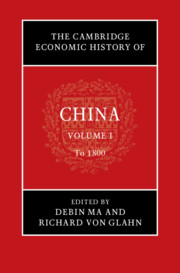Book contents
- The Cambridge Economic History of China
- The Cambridge Economic History of China
- The Cambridge Economic History of China
- Copyright page
- Contents
- Figures
- Maps
- Tables
- Contributors to Volume I
- Acknowledgments
- Note on Citations
- Introduction to Volume I
- Part I Before 1000
- Interlude
- Part II 1000 to 1800
- 7 Ecological Change and Resource Constraints
- 8 Population Change
- 9 Public Finance
- 10 Political Economy
- 11 Law and the Market Economy
- 12 Property Rights and Factor Markets
- 13 The Rural Economy
- 14 Cities and the Urban Economy
- 15 The Monetary System
- 16 Merchants and Commercial Networks
- 17 Foreign Trade
- 18 Production, Consumption, and Living Standards
- Bibliography of Primary Works Cited
- Index
- References
8 - Population Change
from Part II - 1000 to 1800
Published online by Cambridge University Press: 07 February 2022
- The Cambridge Economic History of China
- The Cambridge Economic History of China
- The Cambridge Economic History of China
- Copyright page
- Contents
- Figures
- Maps
- Tables
- Contributors to Volume I
- Acknowledgments
- Note on Citations
- Introduction to Volume I
- Part I Before 1000
- Interlude
- Part II 1000 to 1800
- 7 Ecological Change and Resource Constraints
- 8 Population Change
- 9 Public Finance
- 10 Political Economy
- 11 Law and the Market Economy
- 12 Property Rights and Factor Markets
- 13 The Rural Economy
- 14 Cities and the Urban Economy
- 15 The Monetary System
- 16 Merchants and Commercial Networks
- 17 Foreign Trade
- 18 Production, Consumption, and Living Standards
- Bibliography of Primary Works Cited
- Index
- References
Summary
In the preface to his seminal Studies on the Population of China, 1368–1953, Ping-ti Ho called his book “basically an essay in economic history” that “is not intended to be a demographic analysis, which must be undertaken by experts differently equipped than I.” Ho’s approach was endorsed by John K. Fairbank in his foreword to the book, because “statistics of the modern or would-be-modern type – census data and government statistical reports designed for the purpose – are unavailable for China in the Ming and Ch’ing periods.”1 For Ho and Fairbank, the research approach Ho took in his work belonged to population history, not historical demography. Whereas population history is a subfield of historical studies, using historical research methods to investigate population patterns in history, historical demography is a subfield of demography, mainly using research methods in modern demographic studies, in particular statistical analysis of data such as marriage, reproduction, death, and family structures, and investigates the relationship between fluctuations in these indicators and their social and environmental settings.
Keywords
- Type
- Chapter
- Information
- The Cambridge Economic History of China , pp. 300 - 339Publisher: Cambridge University PressPrint publication year: 2022

